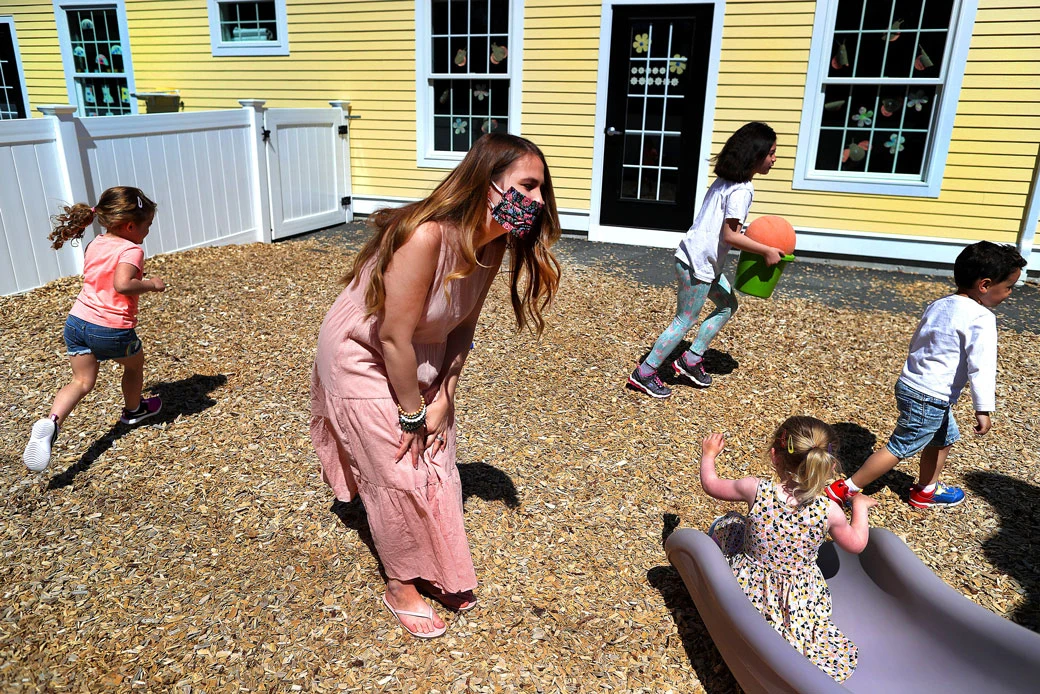How vital is childcare? Sometimes we have no idea the value of something until we no longer have access to it. As a result, this was the message behind “A Day Without Child Care.” In this article, we will take a closer look at what the event achieved, explore data that reveal problems within the childcare industry, and hear what some service providers say about where the industry is today.
More On A Day Without Child Care
On May 9, 2022, a group called Community Change Action hosted an event called “A Day Without Child Care.” The event was nationwide and was an opportunity for teachers and families to celebrate childcare services. In addition, it emphasizes the need for a more affordable and equitable system that offers living wages for those who provide childcare services.In support of “A Day Without Child Care,” many service providers either closed for the day or reduced their hours of operation in protest. In addition, other centers held community events focusing on the country’s childcare situation.
There Are Many Problems Within The System
According to Wilcox Academy of Early Learning CEO Rochelle Wilcox, hiring teachers is a massive issue. She has had such difficulty that she has stopped drawing a salary to keep her childcare facilities open. As much as Wilcox supports events like “A Day Without Child Care,” she chose to keep her centers open for one main reason – the families. Many of her customers are on a low income, and if they encounter childcare issues and have to miss work, they could end up losing their jobs. Wilcox states, “We are hand in hand with the economy, and we are just not respected as such.” She says that professionals like doctors, nurses, and lawyers cannot go to work if no child care services are available for their children.
What The Data Says
The pandemic did not help the childcare crisis. Child Care Aware of America backs that up in a recently published report. The group states close to 9,000 childcare centers in 37 states and nearly 7,000 licensed home-based childcare services in 36 states went out of business between December 2019 and March 2021. Likewise, the National Association for the Education of Young Children made similar discoveries from their survey. Their findings include staff shortages according to 80 percent of those who participated in the survey. Of those, the majority claim that low wages are the main issue.
Child Care Aware of America reports that the average wage nationally for a childcare worker is $12.24 per hour (as of May 2020). To give you an idea of how low a salary is, Stanford University surveyed several hundred childcare providers and found that more than one-third had difficulties paying average household expenses like utilities, food, and rent, adding to the labor shortage. In the words of one child care worker, “During the pandemic, I’ve cared for children without pay, taken reduced pay, given up vacation time, etc. As a result, I became emotionally and physically drained. Something needs to change.”
The Problem Pre-Dates The Pandemic
The Center for the Study of Child Care Employment states that two years into the pandemic, 117,000 fewer child care jobs are available in the US than in February 2020. While that may point to COVID-19 harming the childcare industry, the service was in trouble long before the pandemic took hold. For example, the number of available home-based child care programs dropped in North Carolina between 2019 and 2021. The total decrease was 9 percent. The same state worsened between 2016 and 2018, with a recorded 21 percent decrease.
North Carolina Department of Health and Human Services chief deputy secretary Susan Gale Perry agrees. She says popular belief indicates that the state childcare system was “not a fully functioning system – or even, you could say, a broken system.” She says the situation escalated once federal funding kept child care centers open. However, staffing continues to be an issue. “Parents are paying what a high cost – more than most college tuitions – for child care is, yet the wages of the child care workforce remain only at about $12 an hour.” She states that this is because child care is not a market system but one where the cost to operate the system is not meeting demand.
The Child Care Industry Lacks Respect
There is another reason why childcare workers are leaving the industry. It has nothing to do with the pandemic, either. They feel undervalued. In simple terms, the work is not easy, and the pay is minimal. According to Wilcox, peers often overlook the vital goal of assisting young children in their development through early education. She says child care to many is viewed as babysitting and even her mother asked why Wilcox would put time into “cleaning butts and wiping noses.” She says there is a simple disconnect. “People still view childcare as women’s work; that’s why they feel disrespected.”
There Is An Upside
State and federal legislators are taking note of child care’s importance – and value. As a result, this explains why additional funding streams have become available from both levels of government to help keep childcare service providers in the business. Some of the funding is earmarked for staffing, whether to increase the hourly pay of existing staff or to provide a working wage for new hires.
Final Thoughts
Although the pandemic kicked the child care industry when it was down, it has also helped magnify many problems within the sector pre-COVID. Because of this, attempts are underway to remove childcare from life support and bring it back to health. It won’t be easy, but the benefits should make an effort worthwhile in the long run. With trends pointing to an increased demand for quality childcare services, now is the time to fix the problem so that working parents can easily access reliable childcare services.
Sandra Chiu works as Director at LadyBug & Friends Daycare and Preschool.
re On A Day Without Child Care
On May 9, 2022, a group called Community Change Action hosted an event called “A Day Without Child Care.” The event was nationwide and was an opportunity for teachers and families to celebrate childcare services. In addition, it emphasizes the need for a more affordable and equitable system that offers living wages for those who provide childcare services. IN support of “A Day Without Child Care,” many service providers either closed for the day or reduced their hours of operation in protest. In addition, other centers held community events focusing on the country’s childcare situation.
There Are Many Problems Within The System
According to Wilcox Academy of Early Learning CEO Rochelle Wilcox, hiring teachers is a massive issue. She has had such difficulty that she has stopped drawing a salary to keep her childcare facilities open. As much as Wilcox supports events like “A Day Without Child Care,” she chose to keep her centers open for one main reason – the families. Many of her customers are on a low income, and if they encounter childcare issues and have to miss work, they could end up losing their jobs. Wilcox states, “We are hand in hand with the economy, and we are just not respected as such.” She says that professionals like doctors, nurses, and lawyers cannot go to work if no child care services are available for their children.
What The Data Says
The pandemic did not help the childcare crisis. Child Care Aware of America backs that up in a recently published report. The group states close to 9,000 childcare centers in 37 states and nearly 7,000 licensed home-based childcare services in 36 states went out of business between December 2019 and March 2021. Likewise, the National Association for the Education of Young Children made similar discoveries from their survey. Their findings include staff shortages according to 80 percent of those who participated in the survey. Of those, the majority claim that low wages are the main issue.
Child Care Aware of America reports that the average wage nationally for a childcare worker is $12.24 per hour (as of May 2020). To give you an idea of how low a salary is, Stanford University surveyed several hundred childcare providers and found that more than one-third had difficulties paying average household expenses like utilities, food, and rent, adding to the labor shortage. In the words of one child care worker, “During the pandemic, I’ve cared for children without pay, taken reduced pay, given up vacation time, etc. As a result, I became emotionally and physically drained. Something needs to change.”
The Problem Pre-Dates The Pandemic
The Center for the Study of Child Care Employment states that two years into the pandemic, 117,000 fewer child care jobs are available in the US than in February 2020. While that may point to COVID-19 harming the childcare industry, the service was in trouble long before the pandemic took hold. For example, the number of available home-based child care programs dropped in North Carolina between 2019 and 2021. The total decrease was 9 percent. The same state worsened between 2016 and 2018, with a recorded 21 percent decrease.
North Carolina Department of Health and Human Services chief deputy secretary Susan Gale Perry agrees. She says popular belief indicates that the state childcare system was “not a fully functioning system – or even, you could say, a broken system.” She says the situation escalated once federal funding kept child care centers open. However, staffing continues to be an issue. “Parents are paying what a high cost – more than most college tuitions – for child care is, yet the wages of the child care workforce remain only at about $12 an hour.” She states that this is because child care is not a market system but one where the cost to operate the system is not meeting demand.
The Child Care Industry Lacks Respect
There is another reason why childcare workers are leaving the industry. It has nothing to do with the pandemic, either. They feel undervalued. In simple terms, the work is not easy, and the pay is minimal. According to Wilcox, peers often overlook the vital goal of assisting young children in their development through early education. She says child care to many is viewed as babysitting and even her mother asked why Wilcox would put time into “cleaning butts and wiping noses.” She says there is a simple disconnect. “People still view childcare as women’s work; that’s why they feel disrespected.”
There Is An Upside
State and federal legislators are taking note of child care’s importance – and value. As a result, this explains why additional funding streams have become available from both levels of government to help keep childcare service providers in the business. Some of the funding is earmarked for staffing, whether to increase the hourly pay of existing staff or to provide a working wage for new hires.
Final Thoughts
Although the pandemic kicked the child care industry when it was down, it has also helped magnify many problems within the sector pre-COVID. Because of this, attempts are underway to remove childcare from life support and bring it back to health. It won’t be easy, but the benefits should make an effort worthwhile in the long run. With trends pointing to an increased demand for quality childcare services, now is the time to fix the problem so that working parents can easily access reliable childcare services.
Sandra Chiu works as Director at LadyBug & Friends Daycare and Preschool.



